5g cell towers are new kind of antenna that's being used by wireless companies to offer internet-based services. They have more capabilities than 4g towers and they can be much bigger and stronger.
A lot of cities are worried that these towers could harm their residents. These concerns include aesthetic, privacy, and health concerns.
They're Bigger
With 5G, the frequency that radio waves travel through is greater than 4G- which implies that it requires more towers to transmit data. This can increase the amount of radiation that is released to our surroundings.
This is a big worry for HOA communities as well as business owners, real property investors, and others worried about negative health effects. They fear that adding additional 5g towers will lower property values and negatively impact public health.
safe distance from cell tower to this is to change the way we communicate - through WiFi instead of the traditional mobile networks. It's unlikely to be a quick process however it will eventually happen.
How can this be accomplished? How can we make it safer? The answer is in the technology of a cell tower , which is known as small cells.
They're more expensive

If you're in an urban area, you've probably noticed large towers of cellular equipment that are situated on top of towers and structures. These are cell towers with 4G and they're used to supply wireless networks to the surrounding regions.
They're usually between 50 and 200 feet high, and they're constructed to blend into the surroundings to minimize their aesthetic impact. Compared to 4G, 5G technology needs greater tower coverage in order to cover a wider area.
Visit this site can be difficult to maintain since they require being constantly in operation and delivering fast speeds. As a result, they're more costly than other types of towers.
But if you're a tower operator or the operator of a mobile phone network, it makes sense to upgrade your current towers to 5G in anticipation of the new technologies that are coming to market. Adding these newer technologies to existing sites can help increase the site's capabilities and eventually increase profits for you.
They're more dangerous
5g Towers: What's the Problem?
One of the most significant issues with 5g towers is that they emit more RF radiation than other towers. Click here for more info is because they need to be placed more densely over a large area to ensure coverage.
The radio frequency waves generated by cell phone towers don't possess enough power to cause damage to DNA directly, or even heat tissues of the body, however they can degrade chemical bonds in DNA, which can harm cells and lead to cancer.
The concern is that living near a 5g tower could have negative health consequences.
This is because these towers have a higher chance be placed close to schools and homes, in areas where they transmit radio frequency waves constantly. That means that they will be closer to you than before and the likelihood is higher that radiation is absorbed by your body.
They're Not Required
5G networks use an entirely new portion of the radio spectrum that can transmit data. They are referred to as millimeter waves. They're shorter than traditional radio waves with less than 1-10mm in length. Therefore, they have a higher frequency and can transmit more energy.
In order to provide the super-fast speed and low latency that 5G promises, you need to have a massive number of towers. This means a lot of masts that be able to cover roads, cities as well as business districts, colleges, and even farms.
There are alternative alternatives to provide fast internet service in highly-populated areas. One option is to build small cell stations that are densely distributed to eliminate coverage gaps.
However, the biggest concern is where these cells will go and how they'll affect residents. Local authorities and residents are trying to determine ways to block the installation or stop it from taking place in their community.
